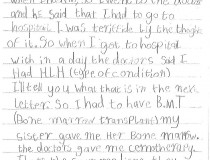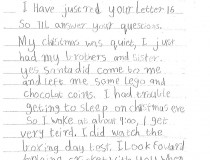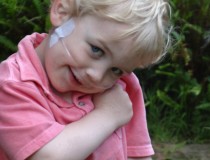What is like to know your child is one of only few in the world with a particular life-threatening disease? In this blog we hear from three RCH families, who would like to share their stories to raise awareness for Rare Disease Day.
Harry’s journey with a rare disease
 Growing up, Harry had always taken longer than other children to recover from a virus, and although his parents Robyn and Tony always knew something wasn’t right, they never imagined their son would become the first patient diagnosed in Australia with XIAP deficiency, a rare and potentially life-threatening disease.
Growing up, Harry had always taken longer than other children to recover from a virus, and although his parents Robyn and Tony always knew something wasn’t right, they never imagined their son would become the first patient diagnosed in Australia with XIAP deficiency, a rare and potentially life-threatening disease.
In January 2013 Harry became extremely unwell. Later his family would learn that this episode was a ‘flare up’ of the rare x-linked disease called XIAP deficiency, something he had been experiencing for years but never knew why. The flare up lasted a month, with high fevers, weight loss and extreme fatigue, Harry spent most days on the couch sleeping up to 18 hours a day.
“Eventually he was able to go back to school but the fatigue continued, he couldn’t participate in many activities, he was just so exhausted,” said Robyn.
When he had another flare up the following month, Harry was admitted to The Royal Children’s Hospital (RCH) and placed under the care of the oncology and immunology teams. A very new test, that had only been available at the RCH for a few months, was performed and Harry was diagnosed with XIAP deficiency.
RCH Paediatric allergist, immunologist and immunopathologist Dr Sharon Choo explained that XIAP deficiency (also known as XLP type 2) is a genetic disorder of the immune system that only affects males.
“Patients with XIAP deficiency are at increased risk of a condition called haemophagocytic lymphohistioctosis (HLH), which consists of prolonged high fevers, low numbers of cells in the blood (red cells, white cells and/or platelets) and an enlarged spleen,” Dr Choo said.
“When Harry was admitted to the RCH his medical team suspected HLH and asked our laboratory to look at why he developed HLH. The results showed that he lacked the XIAP protein. XIAP is an important regulator of the immune system and when it is absent the immune system can get out of control, resulting in the HLH,” she said.
Robyn said the diagnosis was a shock and scary because they knew it was life-threatening and being so rare they didn’t know what to expect.
“When Harry had another flare up just a few months later his medical team decided he would need a Bone Marrow Transplant (BMT). Our whole family went into the same room at RCH Pathology Collection and we were all tested, both to see if we had the same condition as Harry, and to see if we were a bone marrow match,” said Robyn.
The tests results were both promising and devastating for the family. They showed that Harry’s 25-year-old sister was a bone marrow match and could become a donor for Harry, but they also revealed his older brother and his cousin had XIAP deficiency as well.
“When I think about how it feels to have three family members with this rare and life-threatening disease it’s overwhelming. The only comfort is knowing that there is such an advanced multidisciplinary team here at the RCH that have been able to identify the condition and provide treatment.”
“It’s also sobering for us because we now know that my father probably had this condition and we lost him when he was just 39 years of age. He was never diagnosed and never had the chance to undergo the treatment we now have, so we feel very fortunate that the boys will have that opportunity.”
Dr Choo said the only curative treatment for XIAP deficiency is a bone marrow transplant.
“This is a big step for patients and their families. Some family members have just been told they have the disease, whilst other family members are being approached about becoming a bone marrow donor,” Dr Choo said.
“Meanwhile Harry needed to recover from his HLH and then head straight into transplant before he had another flare up of HLH. This is a difficult time for patients because the transplant process itself makes them feel unwell again,” she said.
On 16 September 2013 Harry underwent the BMT. His older sister was able to leave The Royal Melbourne Hospital, where she underwent the procedure to donate her bone marrow, and travel down the road to the RCH to sit with Harry while he received the transplant. Harry then spent the following two months in isolation on Kookaburra (Cancer Care Ward).
“If the transplant is a success then it’s a cure, which is unbelievable and so exciting for us,” said Robyn.
The BMT was a difficult time for Harry, but he bravely fought through. “My sister gave me her bone marrow, and the doctors gave me chemotherapy,” he said. “I had to stay in hospital for a long time and I didn’t really enjoy it.”
Fortunately, Harry has been doing well since the transplant last year and he now has a new lease on life. “My energy levels have been rising slightly and I was finally able to go back to school which was so wonderful. It was really nice to see my friends because I haven’t seen them for ages and I really missed them,” he said. “I fell a bit behind on my maths and other classes so I’m just catching up, but I’m feeling much happier and much better than I used to.”
Robyn says the one piece of advice she has for other parents is to always trust your instincts. “You know when things are out of the ordinary and you know what’s unusual. If you sense something isn’t right you have to keep asking questions and seeking advice,” she says.
“As parents, the journey with rare disease is often scary, because you know the doctors haven’t seen much of this before. There isn’t a big group of children with the same condition, so a lot of things are new. You just have to trust the medical staff and know that they will guide you.”
“Knowing that the first three patients in Australia diagnosed with this condition are within our family can feel isolating but we have been so well looked after here and included in all the support systems through the Children’s Cancer Centre, which has been really helpful.”


Ayva and Jorja’s journey
![Ayva & Jorja[2]](https://blogs.rch.org.au/news/files/2014/02/Ayva-Jorja2-210x160.jpg) Sisters Ayva and Jorja are two of only 40-50 diagnosed children in Australia, and approximately 600 worldwide, with a rare disease called ataxia-telangiectasia (A-T). A-T is a hereditary progressive neurodegenerative disorder.
Sisters Ayva and Jorja are two of only 40-50 diagnosed children in Australia, and approximately 600 worldwide, with a rare disease called ataxia-telangiectasia (A-T). A-T is a hereditary progressive neurodegenerative disorder.
Parents Helen and Chris first noticed symptoms in their daughter Ayva when she was just three-years-old. “Ayva was unsteady on her feet so we took her to a paediatrician who referred us on to the RCH, where she had an MRI,” said Helen.
“At the time nothing was detected but over the next few years she started to slowly deteriorate and was becoming more unstable on her feet. We were told it was likely cerebral palsy,” she said.
Around the time Ayva turned eight years of age her mobility suddenly deteriorated and she needed assistance to walk. After another MRI the team at the RCH noticed a change in her brain function and Ayva was referred on to RCH neurologist Dr Victoria Rodriguez-Casero and in December 2011 she had chromosomal testing, leading to a diagnosis of A-T in January the following year.
“When we found out it was devastating because we knew the prognosis wasn’t good. And then, just two months later, our youngest daughter Jorja was diagnosed with the same condition. We suspected Jorja had it too, because she was developing similar symptoms,” said Helen.
“We knew we had to push through the devastation and at this stage we just manage, because we have to.”
“The girls do physiotherapy, speech therapy and occupational therapy frequently and we are often in for appointments with their specialists at the RCH.”
Ayva is now 10-years-old and Jorja is five-years-old and has just started grade prep. Together with their older sister Kelsey they are loving and caring sisters, who always support each other well. “Jorja helps Ayva with walking to the swings and getting around the house. Some mornings she even helps her big sister get dressed, but only if she’s in a good mood, they are still just normal sisters after all.”
Like all rare diseases, A-T is known as an ‘orphan disease’ because it affects such small percentage of the population. Like all families affected by rare disease the journey can often feel isolating, which is why Rare Disease Day is so important, as it provides an opportunity for families to come together to communicate their experiences and highlight the importance of raising awareness for rare disease, not just today but every day.
“Kids and adults with rare diseases are just as important as those with more a common disease, they are just as special and they need a cure just as much,” said Helen.
“Last year we travelled with the girls to Queensland so they could take part in a research clinic for A-T. It involves most of the kids with A-T from around Australia and we’ll continue to go once a year in the hope the research will lead to a positive outcome.”
“A-T is a complex disease, of all the children with the condition none are exactly the same. The way I try to explain it is if you think of A-T as having 10 different symptoms, one child might have symptom number one and two, another child might have three, four and five and one might have all of the symptoms, they never present in the same way or at the same time.”
“The disease is like a combination of cystic fibrosis, cerebral palsy and muscular dystrophy and also includes immune deficiency and a high rate of developing malignancies such as leukaemia and lymphoma. Most children with A-T are dependent on wheelchairs by the age of 10 and can only get around with assistance. Ayva is almost 11-years-old and most of the time she can only walk assisted, otherwise she has frequent falls.”
“If the girls come into contact with someone with an infectious disease I have to bring them in to the RCH for an immunoglobulin injection immediately to supplement their weakened immune system. We just can’t take the chance. It’s very frustrating when other parents don’t think about children with immune diseases and the consequences of them coming into contact with other sick kids.”
Children with A-T have a life-expectancy to their late teens or early twenties, and usually die from respiratory failure or cancer. There is currently no cure for the disease and no way to slow its progression.
Day-to-day, Helen and Chris work hard to maintain a normal existence and a positive attitude for their girls.
“We treat Ayva and Jorja as normal kids and try not to make A-T stand out. If they have a fall we say ‘up you get, brush yourself off’. We try not to make a big deal of it,” she said.
“Our life has changed significantly. We call it our ‘new normal’.”
I wanted to introduce you to our son Harrison
 Harrison is three years old and has two rare diseases. He is one of approximately 500 children in the world with a disease called Neuroendocrine Cell Hyperplasia of Infancy, more commonly known as NEHI which affects the lungs. He also has a metabolic condition called Congenital Sucrose Isomaltase Deficiency which in simple terms means he can never have sucrose or starch in his diet.
Harrison is three years old and has two rare diseases. He is one of approximately 500 children in the world with a disease called Neuroendocrine Cell Hyperplasia of Infancy, more commonly known as NEHI which affects the lungs. He also has a metabolic condition called Congenital Sucrose Isomaltase Deficiency which in simple terms means he can never have sucrose or starch in his diet.
 As far as we know he is the only person in the world to have both. When Harrison was six weeks old we began our journey into the unknown and ended up at the RCH, a place we began to call home.
As far as we know he is the only person in the world to have both. When Harrison was six weeks old we began our journey into the unknown and ended up at the RCH, a place we began to call home.
With the support of the amazing RCH staff at the ACE Program and our care team across many specialties, we go in now for appointments and when Harrison is unwell or needing tests and monitoring.
Harrison has oxygen on 24/7 and is on a very restricted diet but doesn’t let that stop him tackling life head on. I hope with the evolving knowledge of the specialists and awareness through days like Rare Disease Day, we can get increased support and greater treatment options.
Harrison has taught us what life is truly all about and his strength and determination and love of life is inspiring to anyone who meets him. To all the other families living with a rare disease, it is comforting to know we are not alone.
– Written by Harrison’s mum Tania



